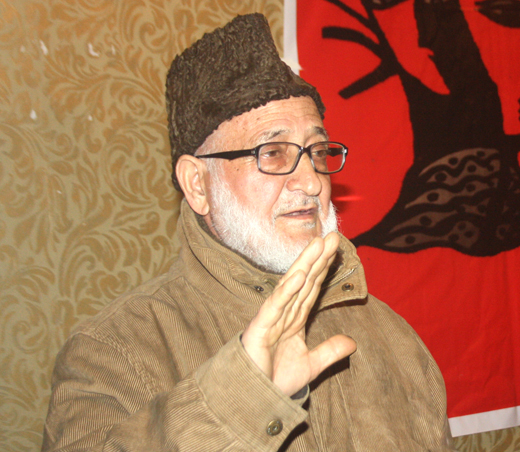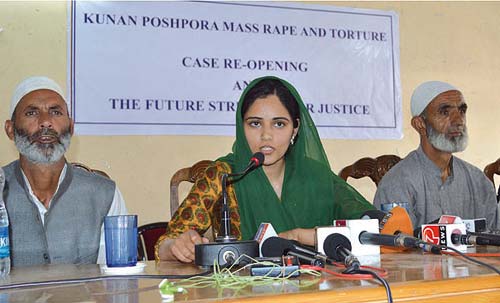From a day long protest at the peak of militancy in 1991 to the return in sharp public focus in 2013, the Kunan case does not seem a nearly quarter-century old for Kashmir. Though it is still fresh in public memory, R S Gull picks up the scattered threads to offer history to a case that many think could be only next to Dhaka-1971.
The most perturbing question that greets people in Delhi these days is: ‘How this Kunan case is back?’ Almost a quarter century later – 23 years to be exact, the bestial orgy of sexual violence was slapped on a contingent of counter-insurgent troops, the case seemingly is so fresh. It has surprised many people. Their belief is that the times have changed and time, mankind has believed perpetually, is the best healer. But Kunan is defying that age-old logic.
J&K has very weak institutional set up but institutions exist. One of them is SHRC, frequently referred as a tooth-less tiger. Even today, it is headless. It was here that the victims of the alleged mass rape had filed a series of applications. Clubbing all these applications, the SHRC on October 19, 2012 recommended reinvestigation of the case through a Special Investigation Team (SIT) to be headed by an officer not below the rank of a DySP. The division bench of the Commission also sought prosecution of the then Director Prosecution for seeking closure of the case on the grounds that the perpetrators were “untraceable” and all those who approved his decision that he had taken by “overstepped his brief”.
The SHRC decision was based on the statements of 18 of the victims recorded in eight sittings. Six petitions filed separately between 2004 and 2007 pertained to 34 women alleging the investigations in the case were not carried out and the justice is still due to them. Terming it a “horror night”, the Commission accused successive state government of being “callous, negligent, insensitive and indifferent” towards the victims and ruled they be paid a compensation of two lakh rupees each.
For the victims and the defenders of the human rights, SHRC decision was a major victory. When the incident took place during the intervening night of February 23 and 24, 1991, the area was snowbound. For a few days, locals still remember, they were in a tight cordon and no movement was permitted. It was during this lose ‘preventive’ cordon, the villagers had complained to the army.
 The then Deputy Commissioner Kupwara S M Yasin was informed by one of his lower grade officials. As Yasin visited the village on March 5, 1991, he wrote a letter to his high-ups including the then governor Garesh Chander Saxena on March 7. On his insistence, the police at Trehgam police station on March 18, registered FIR 10/1991 under section 376, 452 and 342 and took up the basic investigations that included medical examination of 32 victims between March 15 and 21suggested they had wounds on their chests and abdomens. Hymens of three of the unmarried were found torn.
The then Deputy Commissioner Kupwara S M Yasin was informed by one of his lower grade officials. As Yasin visited the village on March 5, 1991, he wrote a letter to his high-ups including the then governor Garesh Chander Saxena on March 7. On his insistence, the police at Trehgam police station on March 18, registered FIR 10/1991 under section 376, 452 and 342 and took up the basic investigations that included medical examination of 32 victims between March 15 and 21suggested they had wounds on their chests and abdomens. Hymens of three of the unmarried were found torn.
“I feel ashamed to put in black and white what kind of atrocities and their magnitude was brought to my notice on the spot,” Yasin wrote in his detailed letter. “A large number of armed personnel entered into the houses of villagers and at gunpoint they gang-raped 23 ladies.”
It was this letter that was leaked to the media and the crisis actually started becoming news. Next day when a battery of reporters visited the village, they had to keep their car on the main road and move through a hip-level snow for four kilometers to reach Kunan. Justice (retd) Baha-ud-Din Farooqui, who then as head of J&K People’s Basic Rights Committee visited the village of March 17 to find how the “normal investigation procedures were ignored”. Divisional Commissioner Wajahat Habibullah visited the village a day later on March 18 along with Lt Col Naeem Farooqi, Commandant of the 76 Bn BSF Tyagi, and Kupwara’s DC and SSP. Kashmir observed a complete strike against the incident on March 20, almost a month later.
By then, police had taken control of whatever evidence was there in the village: empty wine bottles, name plates, a number of torn clothes of women having tell-tale marks of violence, fingerprints and fluids. The officer who was assigned investigation of the case proceeded on leave. Within days, Yasin was shifted. Investigations stopped. Army set up its own investigation team that termed the allegations baseless. The then DGP addressed a news conference in Srinagar saying the same so did the governor on Doordarshan. On October 21, 1991 according to details revealed by the police, the case was closed as ‘untraced’ and the prosecution termed the “unfit for criminal prosecution” as the “incident was stage-managed”!
















